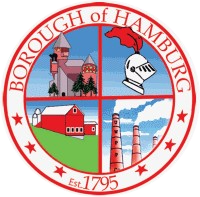Located in Sussex County, the northernmost county in the State of New Jersey, at the intersection of State Routes 23 and 94, the Borough of Hamburg is the epitome of a small town. It has a total area of 1.165 square miles which includes 1.142 square miles of land and 0.023 square miles of water. Hamburg is bordered on the east, west and north by Hardyston Township and Franklin Borough on the south. As of the 2010 United States Census, the borough’s population was 3,277.
Hamburg is governed under the Borough form of New Jersey municipal government. The government consists of a Mayor and six member Borough Council with all positions elected at large. A Mayor is elected directly by the voters to a four-year term of office. Council members serve three-year terms on a staggered basis, with two seats coming up for election each year. A schedule of meeting dates for the Mayor/Council as well as other Borough boards and committees may be found on the Mayor & Council page of this website.
Hamburg is located in the 5th Congressional District and is part of New Jersey’s 24th state legislative district.
BRIEF HISTORY
- 1753 Sussex County is formed, Hamburg is part of New Town
- 1762 Hamburg becomes part of the newly established Hardyston Township.
- 1792 Vernon Township is formed from Hardyston, Hamburg is included within the boundaries of Vernon.
- 1810 Hamburg becomes a stopping place for stagecoaches traveling on the now completed Paterson-Hamburg Turnpike which ran from Milford, Pennsylvania to Hoboken, New Jersey.
- 1852 The boundary line changes so that Hamburg is again in Hardyston Township, where it remains until its incorporation in 1920.
- 1888 The Hamburg Concert Band is organized and weekly summer concerts become a feature of community life. A bandstand was located in the center of town where Route 23 and 94 intersect.
- 1906 the Hardyston National Bank is organized and one can still see the works on the building located on Main Street.
- 1909 The Fire Department is formed and the first equipment purchased. A hand-drawn hook and ladder truck with 24 rubber buckets.

- 1928 Joseph Urban designed and built the famous Gingerbread Castle. It took two years to build and was completed at a cost of $250,000.00. The castle provided a perfect setting for figurines illustrating fairy tale characters from the Grimm Brothers’ collection of folk tales. The Borough became known as “the Children’s town” and remains so to this day. You may notice the streets have fairy tale names such as Cinderella, King Cole, Prince and Wishing Well Road.
PROMINENT EARLY CITIZENS
Believed to be the earliest known settler, Joseph Walling, Sr. came to Hamburg circa 1740 and built an inn in the center of town (what is now the Wells Fargo Bank). It was a landmark for over one hundred years and, for a short time, Hamburg was called Wallings in his honor. During the Revolution local legend has it that General George Washington spent the night in the Walling Inn while enroute to Easton, Pennsylvania from Newburgh, New York. A stone marker on Route 94 South indicates the spot where it is also said that Washington and several troops spent the night in a field near Hamburg in 1779 while heading to Morristown.
Around 1770, settler Joseph Sharp Constructed a mill and a forge, the Sharpsboro Iron Works, and the town was briefly renamed Sharpsboro.
Governor Daniel Haines remains the town’s most famous citizen. He settled in Hamburg at the age of 23 as a lawyer. Some of his credentials include being ordained an elder of the church, Governor of the State in 1843 and again in 1847, Justice of the State Supreme court for fourteen years, and in 1877 he was involved in the making of a new state constitution.
Colonel Joseph Edsall, owner of a forge and a blacksmith shop in Hamburg was elected to the United State Congress in 1847
This information and more may be found in “All About Hamburg, a history of Hamburg, New Jersey” by Marion E. Wood.
